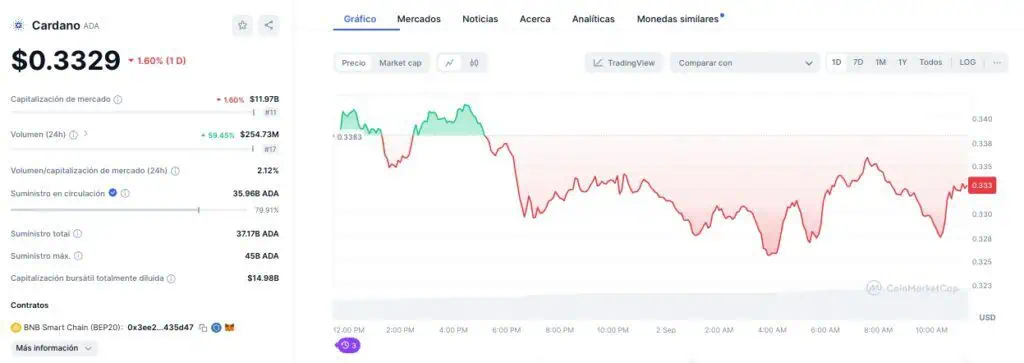
The arrival of the Chang upgrade has ushered in a new era marked by decentralized governance on the Cardano network.
The Cardano Foundation confirmed on social media that the Chang upgrade has been successfully implemented on Cardano, representing a significant step towards autonomy and community governance on the blockchain.
With the successful activation of this new upgrade, Cardano, created by Ethereum co-founder Charles Hoskinson, is taking a significant step towards a new era in its development and evolution, known as the Voltaire era. This phase focuses on the implementation of governance mechanisms that will allow holders of ADA, Cardano’s native cryptocurrency, to actively participate in decision-making regarding the future of the network.
Chang's first phase gets underway
As reported by this media, the Chang update is implemented on the main network in two phases, the first being the boot phase that was launched on September 1This phase, already active, is designed to establish a community governance structure.
According to CIP-1694, three governance entities have been created: the Constitutional Committee, the Delegated Representatives (dReps), and the Stake Pool Operators (SPOs). This new structure means that Cardano’s founding entities, such as the Cardano Foundation and Input Output Global (IOG), will no longer have exclusive control over blockchain upgrades. Instead, these decisions will be delegated to the aforementioned new governance entities.
Cardano founder Charles Hoskinson has noted that this upgrade represents the biggest event in the history of Cardano and the blockchain industry, setting a new standard for on-chain governance. As the second phase rolls out, expected in 90 days, new governance entities will be given full powers to participate in decision-making, allowing the Cardano community to have an active voice in the development of the blockchain.
According to the Cardano Foundation, the second activation phase of Chang will introduce the final characteristics of governance in the blockchain.
ADA becomes a governance token
With the arrival of Chang and the Voltaire era, Cardano seeks to consolidate its commitment to decentralization and self-management, transforming its native cryptocurrency, ADA, into a governance token through which its holders will be able to vote on development proposals and elect their governance representatives on the blockchain.
This new approach from Cardano not only aligns with the decentralization principles that define the cryptocurrency industry, but also presents itself as a strategy that can mitigate the attention of securities regulators by giving ADA a broader and more functional use.
According to data from CoinMarketCap, the ADA price had risen by almost 2% after the successful implementation of the Chang upgrade. However, at the time of writing, the cryptocurrency has corrected by about 1,6% and is trading at around $0,33 per token.

Source: CoinMarketCap
The evolution of Cardano
The transition to a decentralized governance structure is a process that has been underway since Cardano’s inception. The previous development era, known as Shelley, laid the groundwork for decentralization by allowing users to delegate their ADA holdings to pools, but the Voltaire era takes this concept a step further by allowing the community as a whole to participate in the governance of the network.
Giorgio Zinetti, CTO of the Cardano Foundation, told CoinDesk in an interview that this evolution is essential for Cardano’s future as it seeks to become a truly self-sustaining and self-governing ecosystem. “The governance that Chang introduces puts us in a unique position in the blockchain space, where the community has real control over its future.”, Zinetti said.
Overall, Cardano’s Chang upgrade represents a crucial step forward in the quest for a decentralized governance system that empowers the community and encourages active participation from ADA holders. Hoskinson noted that as the second phase rolls out, Cardano is poised to become a role model in the implementation of governance mechanisms in the blockchain industry.


